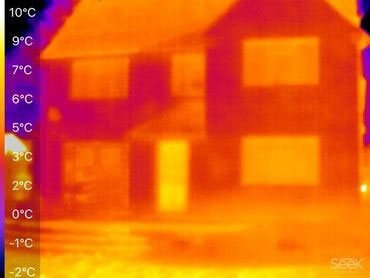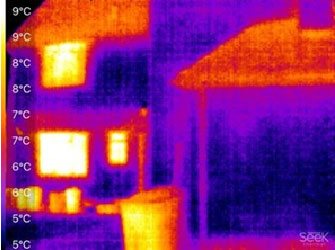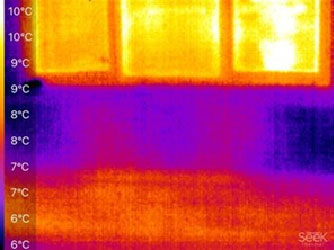Detect Heat Loss, Damp and Structural Issues with a Professional Thermal Imaging Survey
Are you noticing cold spots, high energy bills or signs of damp in your home? Many issues in residential properties go unnoticed until they cause real damage and that’s where a thermal imaging survey can help.
At Surveying Cymru, we provide expert thermal imaging surveys for homeowners and landlords looking to understand the thermal performance of their property. We can use infrared cameras to find hidden heat loss, insulation issues, moisture problems, air leaks, and more. This can be done quickly and accurately without disturbing walls or floors.
If you want to feel sure that your home is warm, energy efficient, and safe, start with a thermal survey.
What Is a Thermal Imaging Survey?
A thermal imaging survey, or thermographic survey, uses infrared technology. It measures temperature differences on walls, ceilings, floors, doors, and windows. The system then translates these temperature readings into visual images that show the distribution of heat in your property.
How Does It Work?
All objects emit infrared energy (heat) as a function of their temperature. A thermal camera detects this energy and creates a digital image based on temperature differences. These images can reveal:
- Heat escaping through uninsulated or poorly sealed areas
- Cold air entering through gaps or cracks
- Moisture intrusion and potential damp
- Electrical faults and overloaded circuits
- Underfloor heating or pipe issues
- Poorly performing cavity or party wall insulation
Because different materials retain heat differently, these surveys can uncover issues that would be invisible to the naked eye.


WHAT OUR CLIENTS SAY
Why Homeowners and Landlords Use Thermal Imaging Surveys
Thermal imaging is a valuable diagnostic tool that can help prevent expensive repairs, improve comfort, and reduce energy waste. Here’s why more and more property owners are choosing this service:
Identify Heat Loss Quickly
Thermal surveys reveal exactly where your property is losing heat, whether through the roof, walls, windows, or floors. Once identified, you can take steps to improve insulation and lower your heating bills.
Detect Damp and Moisture Intrusion
Moisture in walls, ceilings or floors can often go undetected until it causes visible damage. Thermal imaging allows you to spot damp early by showing the colder areas where moisture is present, helping prevent mould growth and structural issues.
Check Insulation Performance
A survey will check if your cavity wall, party wall, or loft insulation is working well. It will also see if it has slumped, degraded, or was not installed correctly.
Diagnose Building Faults
Thermal surveys can find problems like missing insulation, cold bridging, air leaks, or flat-roof defects. This helps save time and money on repairs.
Verify Heating Systems
Thermal cameras can help locate underfloor heating pipes and check radiators for cold spots.
Book your thermal imaging survey with Surveying Cymru today – accurate results, expert guidance, and clear next steps.

WHAT OUR CLIENTS SAY
Our Thermal Imaging Survey Process
At Surveying Cymru, we deliver a clear and professional service from start to finish:
Initial Consultation
We discuss the issues you’re experiencing, whether it’s damp, drafts, uneven heating, or energy inefficiency.
On-Site Thermal Survey
Our experienced surveyors will attend your property with professional-grade thermal cameras, capturing high-resolution images of key areas. We typically carry out surveys in cooler weather conditions or early mornings for optimal results.
Detailed Image Report
We provide a comprehensive report featuring thermal images, descriptions of problem areas, and suggested remedial actions. Everything is explained clearly, without jargon.
Expert Recommendations
Whether you need insulation upgrades, ventilation adjustments or further investigation, we offer independent advice, not sales pitches. We can also connect you with trusted installers if work is required.
Who Can Benefit from a Thermal Survey?
We work with both homeowners and landlords, providing trusted survey services across South Wales, Gloucestershire and Herefordshire.
Our clients typically include:
- Homeowners dealing with unexplained cold areas or high energy bills
- Buyers and sellers looking for peace of mind before or after a sale
- Landlords managing insulation upgrades for compliance or EPC improvements
- Housing associations planning energy efficiency projects
- Retrofit assessors who need thermal evidence for PAS2035 compliance
Whether you own a traditional stone cottage or a modern build, thermal imaging is a non-invasive way to understand how your home performs, and how to improve it.
Get in touch today to book your survey or request a call back.
What Can a Thermal Imaging Survey Detect?
Our surveys can be used to identify a wide range of problems in residential properties:
- Missing or failed cavity wall insulation
- Slumped loft insulation
- Cold bridging across steel beams or joists
- Draughts around windows, doors and pipework
- Damp areas and water ingress
- Flat-roof leak detection
- Leaking or blocked underfloor heating
- Boiler and radiator heat mapping
- Internal structural issues behind plaster or render
No need for destructive investigations – just fast, accurate insights that help you make better decisions.
FAQs About Thermal Imaging Surveys
Cooler months, early mornings or late evenings provide better conditions for detecting heat loss. Surveys during warmer periods may be less effective.
Yes, it’s completely non-invasive and uses infrared light only. There is no risk to occupants, pets or property.
We recommend closing all windows and doors, running your heating for a short period before the survey, and keeping access to all rooms clear.
A typical survey takes between 60–90 minutes, depending on the size and complexity of the property.
Book Your Thermal Imaging Survey Today
If you want to understand how your home retains heat, spot damp problems early, or identify insulation issues before they escalate a thermal imaging survey is a smart investment.
At Surveying Cymru, we combine professional technology with expert insight, giving you the knowledge to make better decisions about your home.
📞 Call our team now on 01600 715350 to schedule your survey.
Email nick@surveyingcymru.co.uk